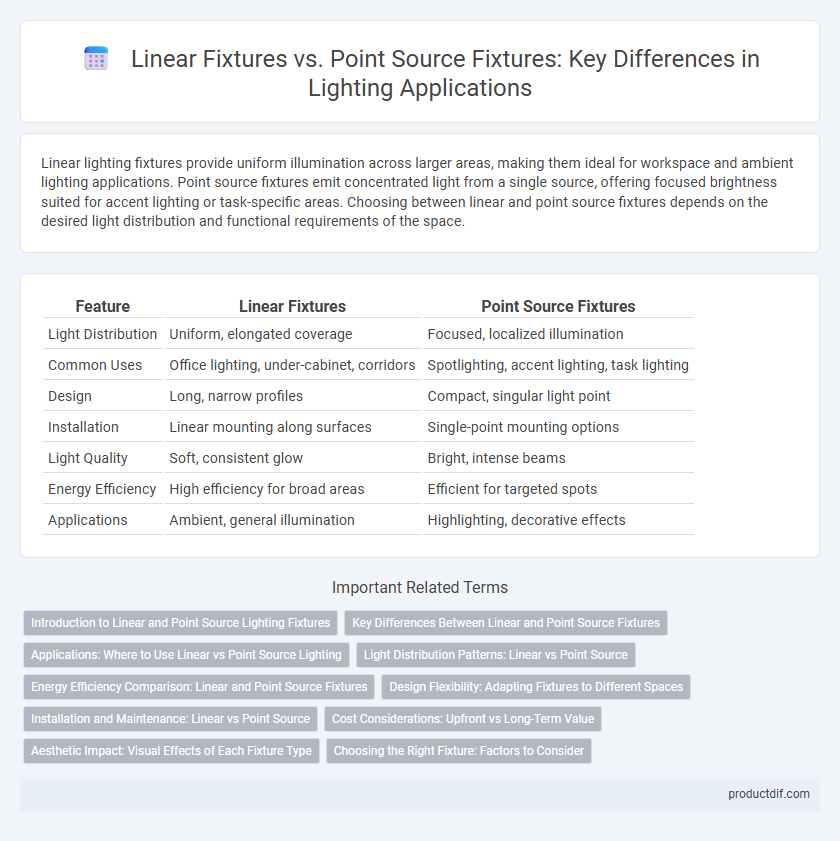Linear lighting fixtures provide uniform illumination across larger areas, making them ideal for workspace and ambient lighting applications. Point source fixtures emit concentrated light from a single source, offering focused brightness suited for accent lighting or task-specific areas. Choosing between linear and point source fixtures depends on the desired light distribution and functional requirements of the space.
Table of Comparison
| Feature | Linear Fixtures | Point Source Fixtures |
|---|---|---|
| Light Distribution | Uniform, elongated coverage | Focused, localized illumination |
| Common Uses | Office lighting, under-cabinet, corridors | Spotlighting, accent lighting, task lighting |
| Design | Long, narrow profiles | Compact, singular light point |
| Installation | Linear mounting along surfaces | Single-point mounting options |
| Light Quality | Soft, consistent glow | Bright, intense beams |
| Energy Efficiency | High efficiency for broad areas | Efficient for targeted spots |
| Applications | Ambient, general illumination | Highlighting, decorative effects |
Introduction to Linear and Point Source Lighting Fixtures
Linear lighting fixtures provide continuous illumination along a single axis, ideal for evenly lit spaces such as offices and corridors. Point source fixtures emit light from a single, concentrated point, creating focused beams suited for accent or task lighting. Understanding their distinct light distribution patterns is essential for optimizing spatial ambiance and energy efficiency in architectural design.
Key Differences Between Linear and Point Source Fixtures
Linear fixtures distribute light evenly along their length, creating uniform illumination ideal for workspaces and corridors, while point source fixtures emit light from a single concentrated point, producing focused beams suitable for accent lighting and highlighting specific areas. Linear fixtures typically offer softer shadows and wider coverage, whereas point source fixtures generate sharper shadows and more directional light. Energy efficiency and fixture design vary significantly, with linear fixtures often integrated into architectural elements and point sources enabling adjustable, spotlight-style applications.
Applications: Where to Use Linear vs Point Source Lighting
Linear fixtures excel in providing uniform, continuous illumination ideal for offices, retail spaces, and corridors where consistent light distribution enhances visibility and aesthetics. Point source fixtures offer focused, directional lighting suitable for accentuating artwork, highlighting architectural features, or creating task lighting in kitchens and workspaces. Choosing between linear and point source lighting depends on the application's need for broad ambient light versus targeted, high-intensity illumination.
Light Distribution Patterns: Linear vs Point Source
Linear fixtures provide a uniform light distribution along a defined path, creating consistent illumination ideal for task areas and accentuating architectural lines. Point source fixtures emit light from a single focal point, producing concentrated beams with varying spread angles suited for spotlighting and accent lighting. Understanding these distinct light distribution patterns helps optimize lighting design for both functional efficiency and aesthetic impact.
Energy Efficiency Comparison: Linear and Point Source Fixtures
Linear fixtures often provide superior energy efficiency compared to point source fixtures due to their ability to distribute light more evenly over larger areas, reducing the need for multiple fixtures. Point source fixtures concentrate light in specific spots, which can lead to increased energy consumption when multiple units are required to achieve uniform illumination. Efficient LED technology in both types enhances energy savings, but linear LED fixtures typically achieve better lumen-per-watt performance for continuous lighting applications.
Design Flexibility: Adapting Fixtures to Different Spaces
Linear fixtures offer superior design flexibility by providing continuous, uniform illumination ideal for long corridors, office spaces, and workstations. Point source fixtures, with their concentrated light emission, excel in accent lighting and highlighting specific areas or objects. Choosing between these fixtures depends on spatial requirements and the desired lighting effect, enabling designers to adapt lighting solutions to diverse architectural environments.
Installation and Maintenance: Linear vs Point Source
Linear fixtures offer streamlined installation with continuous mounting options that reduce the number of connection points and simplify wiring, resulting in lower labor costs and faster setup. Point source fixtures, having multiple discrete units, often require individual mounting and wiring, increasing installation complexity and time. Maintenance for linear fixtures is generally more efficient due to easier access to integrated components, whereas point source fixtures may demand more frequent service interventions because of their dispersed arrangement.
Cost Considerations: Upfront vs Long-Term Value
Linear fixtures generally have higher upfront costs due to their extended design and installation complexity, but they offer greater long-term value through even light distribution and energy efficiency. Point source fixtures are typically more affordable initially, ideal for targeted lighting, but may incur higher maintenance and energy expenses over time. Evaluating the total cost of ownership, including energy consumption and replacement frequency, is crucial when choosing between linear and point source lighting solutions.
Aesthetic Impact: Visual Effects of Each Fixture Type
Linear lighting fixtures create elongated, continuous lines of light that emphasize architectural features and add a modern, sleek aesthetic to spaces. Point source fixtures produce focused pools of light with sharp shadows, enhancing texture and depth while highlighting specific objects or areas. The choice between linear and point source fixtures dramatically influences the visual dynamics, mood, and spatial perception within interior and exterior environments.
Choosing the Right Fixture: Factors to Consider
When selecting between linear fixtures and point source fixtures, consider the application's lighting needs, such as uniformity and coverage; linear fixtures excel at providing continuous, evenly distributed illumination, ideal for workspaces and hallways, while point source fixtures concentrate light in specific areas, suitable for accent or task lighting. Evaluate the spatial layout and mounting options, since linear fixtures often require precise alignment and longer runs, whereas point sources offer flexible positioning and focused beams. Energy efficiency, maintenance requirements, and aesthetic preferences should also influence the decision to ensure optimal performance and integration with the interior design.
Linear fixtures vs Point source fixtures Infographic

 productdif.com
productdif.com